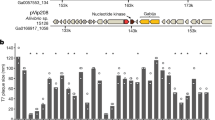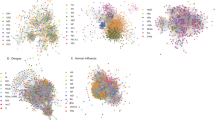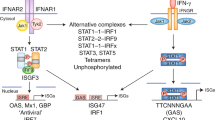Abstract
Although interferons (IFNs) were originally described as proteins conferring antiviral resistance to eukaryotic cells1, various additional biological effects have since been attributed to them, including inhibition of cell proliferation and modulation of the immune response2. More recently it was recognized that interferons from different sources have similar amino acid sequences, suggesting their evolutionary relationship. When the sequences of human interferons of the α and β type were aligned to give maximum homology, a largely conserved region was found near the carboxyl terminus of the molecules3,4. The homology of human leukocyte IFN-α1 and human fibroblast interferon between positions 111 and 166, for instance, was 40%. As conservation of segments of polypeptide chains during evolution may indicate their functional importance5, we synthesized three carboxyl-terminal fragments of human IFN-α1 (ref. 6) ranging in size from 33 to 96 amino acid residues. If the folding of these fragments was similar to that of the corresponding segments in the intact protein, it was conceivable that they had biological activity and that antibodies raised against the synthetic fragments cross-reacted with natural interferon. Such antibodies could be used for the affinity purification of human interferon produced in bacteria and for radioimmunoassays. As we show here, none of the fragments had antiviral activity. A mouse monoclonal antibody prepared against a 56-residue fragment also bound intact IFN-α1 and IFN-α2 without neutralizing their antiviral effect. Thus, this antibody, directed against a largely conserved region, may show substantial cross-reactivity within the interferon protein family.
This is a preview of subscription content, access via your institution
Access options
Subscribe to this journal
Receive 51 print issues and online access
$199.00 per year
only $3.90 per issue
Buy this article
- Purchase on Springer Link
- Instant access to full article PDF
Prices may be subject to local taxes which are calculated during checkout
Similar content being viewed by others
References
Isaacs, A. & Lindenmann, J. Proc. R. Soc. B147, 258–267 (1957).
Stewart, W. E. The Interferon System (Springer, New York, 1979).
Taniguchi, T. et al. Nature 285, 547–549 (1980).
Goeddel, D. V. et al. Nature 290, 20–26 (1981).
Gutte, B. J. biol. Chem. 252, 663–670 (1977).
Mantei, N. et al. Gene 10, 1–10 (1980).
Merrifield, R. B. J. Am. chem. Soc. 85, 2149–2154 (1963).
Barany, G. & Merrifield, R. B. in The Peptides Vol. 2 (eds Gross, E. & Meienhofer, J.) 1–284 (Academic, New York, 1980).
Gutte, B., Däumigen, M. & Wittschieber, E. Nature 281, 650–655 (1979).
Wetzel, R. Nature 289, 606–607 (1981).
Rekker, R. F. The Hydrophobic Fragmental Constant (Elsevier, Amsterdam, 1977).
Provencher, S. W. & Glöckner, J. Biochemistry 20, 33–37 (1981).
Hayes, T. G. Biochem. biophys. Res. Commun. 95, 872–879 (1980).
Köhler, G. & Milstein, C. Nature 256, 495–497 (1975).
Fazekas de St. Groth, S. & Scheidegger, D. J. Immun. Meth. 35, 1–21 (1980).
Streuli, M., Nagata, S. & Weissmann, C. Science 209, 1343–1347 (1980).
Arnon, R., Maron, E., Sela, M. & Anfinsen, C. B. Proc. natn. Acad. Sci. U.S.A. 68, 1450–1455 (1971).
Audibert, F. et al. Nature 289, 593–594 (1981).
Secher, D. S. & Burke, D. C. Nature 285, 446–450 (1980).
Morser, J., Meager, A., Burke, D. C. & Secher, D. S. J. gen. Virol. 53, 257–265 (1981).
Montagnier, L., Laurent, A.-G. & Gruest, J. C. r. Acad. Sci., Paris D291, 893–896 (1980).
Staehelin, T. et al. Proc. natn. Acad. Sci. U.S.A. 78, 1848–1852 (1981).
Author information
Authors and Affiliations
Rights and permissions
About this article
Cite this article
Arnheiter, H., Thomas, R., Leist, T. et al. Physicochemical and antigenic properties of synthetic fragments of human leukocyte interferon. Nature 294, 278–280 (1981). https://doi.org/10.1038/294278a0
Received:
Accepted:
Issue Date:
DOI: https://doi.org/10.1038/294278a0
This article is cited by
-
Physical principles of protein structure and protein folding
Journal of Biosciences (1985)
Comments
By submitting a comment you agree to abide by our Terms and Community Guidelines. If you find something abusive or that does not comply with our terms or guidelines please flag it as inappropriate.



